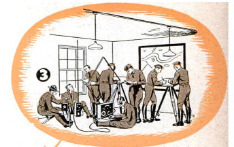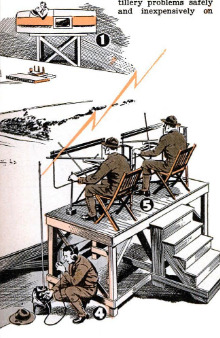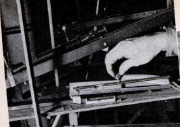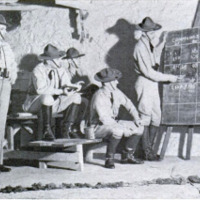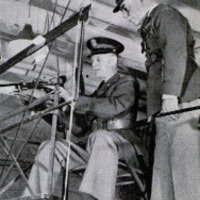-
Title (Dublin Core)
-
Train on toy battlefield
-
Article Title and/or Image Caption (Dublin Core)
-
Train on toy battlefield
-
extracted text (Extract Text)
-
on a scale of one foot to 100 yards,
in the armory cellar. Next he de-
veloped an intricate system of mount-
ing and controlling low-power rifles
so that their aiming, range, trajec-
tory, and other factors would sim-
ulate those found in large 155-mm.
howitzers. He completed the job by
setting up side-line observation posts,
an elevated dummy plane cockpit for
“aerial” observation, and a compre-
hensive communication network link-
ing gunners, observers, and fire-con-
trol officers. These technicians, to-
gether with radio and telephone op-
erators, pilots, staff officers, and other
Army personnel can now work out ar-
tillery problems safely
and inexpensively on
the seventy-five-foot cellar battle site.
All made to scale, “enemy” gun emplace-
ments, toy soldiers, trucks, houses, barns,
roads, streams, bridges, artificial hills,
woods, and streams dot the miniature ter-
rain, making it exceptionally realistic. Some
of the objects are movable. A soldier on the
sidelines, for example, can suddenly yank a
string to haul a patch of trees out of the
way, revealing a hidden column of advanc-
ing troops. In this manner, it is possible to
test the speed with which a barrage can be
laid down to block or wipe out the enemy force.
Firing directions are radioed to gunners from
a second-floor office, where staff officers, out of
sight of the battlefield, hover over maps of the
terrain, figuring out the tricky problems of gun
range, type of shell, powder charge, elevation,
and other factors. The gunners themselves nev-
er watch their targets, for the guns are aimed
by setting calibrated controls as explicitly di-
rected by officers in the upstairs
fire-control headquarters.
‘When the guns are fired, the
aerial observer in the elevated
plane cockpit, and a corps of
side-line observers who peer
through field glasses and spe-
cial telescopes, watch the hits.
If the shells are landing beyond
or short of their mark, or to the
right or left, the observers gauge
the distance and radio the infor-
mation to fire-control headquar-
ters. Here adjustments are made
and revised orders relayed to the
gunnery commanders.
-
Contributor (Dublin Core)
-
A. Eriss (article writer)
-
Language (Dublin Core)
-
eng
-
Date Issued (Dublin Core)
-
1940-06
-
pages (Bibliographic Ontology)
-
111-113
-
Rights (Dublin Core)
-
Public domain
-
Archived by (Dublin Core)
-
Sami Akbiyik
-
Marco Bortolami (editor)
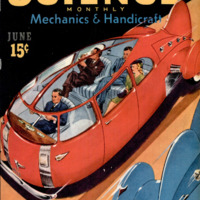 Popular Science Monthly, v.136, n. 6, 1940
Popular Science Monthly, v.136, n. 6, 1940

